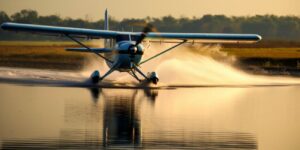The primary characteristic that sets aircraft grade plywood apart is its impeccable strength-to-weight ratio. This is achieved through meticulous manufacturing processes and the use of high-quality raw materials. Unlike conventional plywood, which may vary in terms of quality and consistency, aircraft grade plywood adheres to strict specifications to meet the demanding requirements of the aerospace sector.
One of the key components of aircraft grade plywood is the wood veneer used in its construction. The veneers are typically made from hardwood species, such as birch, mahogany, or spruce, chosen for their superior strength and resistance to warping. These veneers undergo a meticulous preparation process, including precise cutting and laminating, to ensure uniform thickness and optimal structural integrity.
The manufacturing process also involves the use of high-quality adhesives specifically formulated for aviation applications. These adhesives contribute to the plywood’s ability to withstand the rigors of flight, including changes in temperature, humidity, and pressure. The bonding process is often conducted under carefully controlled conditions to eliminate any potential weaknesses in the plywood structure.
One of the notable advantages of aircraft grade plywood is its resistance to delamination, a critical factor in ensuring the safety and longevity of aircraft components. Delamination refers to the separation of layers in the plywood, and in aviation, any compromise in structural integrity can have severe consequences. The use of impact-resistant adhesives contributes to the plywood’s ability to withstand stress and maintain its cohesive structure.
In terms of applications, aircraft grade plywood finds use in various critical components of an aircraft, including the construction of wings, fuselage panels, and interior components. Its lightweight nature is particularly advantageous, as it helps reduce the overall weight of the aircraft, leading to improved fuel efficiency and performance.
When it comes to meeting industry standards, aircraft grade plywood undergoes rigorous testing and certification processes to ensure it complies with aviation authorities’ stringent requirements. This includes assessments of strength, durability, and fire resistance, among other crucial factors.
Plywood grades and characteristics: from a-a to b/bb
When it comes to choosing plywood for your construction or woodworking projects, understanding the various grades and their characteristics is crucial. Plywood is graded based on the quality of its face and back veneers, and the grading system provides valuable information about the appearance and performance of the plywood sheets.
The most common grades you’ll encounter include AA, AB, AC, BC, CD, and DD, each indicating the quality of the plywood’s surfaces. Let’s delve into the specifics of some popular grades:
- AA Grade: This is the highest quality plywood available. Both the face and back veneers are free from any defects, offering a smooth and consistent appearance. AA grade plywood is often used in high-end furniture and cabinetry where a flawless finish is essential.
- AB Grade: With a high-quality face veneer and a back veneer that may have slight imperfections, AB grade plywood strikes a balance between appearance and cost. It is a versatile choice suitable for a range of applications, including furniture, cabinets, and paneling.
- BC Grade: BC grade plywood is known for its solid performance. While the face veneer may have some knots and defects, the back veneer tends to be of a lower grade. This makes BC grade plywood an excellent choice for structural applications such as sheathing and subflooring.
Additionally, you may come across grades like C, D, and X, each indicating a different level of quality for the face and back veneers. The letter ‘X’ is often used to denote that the plywood is suitable for exterior use, thanks to the application of waterproof glue.
Understanding the grading system is only part of the equation. Plywood is also categorized based on the bonding between layers. One common classification is the Exposure Durability Rating, denoted by the letters Exterior (EXT), Exposure 1 (X1), Exposure 2 (X2), and Interior (INT). This rating provides information about the plywood’s resistance to moisture and weathering.
It’s important to note that the grading system may vary slightly depending on the country and manufacturing standards. Always check the manufacturer’s specifications to ensure you are selecting the right grade for your project.
Plywood manufacturing process: hot pressing and gluing the veneers
In the fascinating realm of plywood manufacturing, the intricate dance of elements like hot pressing, gluing, cutting, and the meticulous handling of veneers takes center stage. This symphony of craftsmanship transforms raw materials into the versatile building material we know as plywood.
The process initiates with the selection of high-quality veneers, thin slices of wood that serve as the foundational layers. These veneers undergo a careful sorting process, ensuring uniformity in thickness and quality. The success of the entire manufacturing hinges on this crucial step.
Once sorted, the veneers move into the gluing phase, a pivotal juncture where they become a cohesive unit. Advanced adhesives are applied with precision, bonding the veneers together to create a robust composite structure. The choice of adhesive is critical, as it determines the plywood’s durability and resilience.
Following the gluing process, the assembled layers enter the stage of hot pressing. This involves subjecting the composite to high temperature and pressure, a transformative act that melds the veneers into a unified whole. The result is a sturdy and dimensionally stable sheet of plywood, ready to endure a myriad of applications.
The artistry of cutting then takes precedence, shaping the plywood sheets into desired dimensions. Precision is paramount, ensuring that each cut aligns with the intended use. This step in the manufacturing process defines the versatility of plywood, catering to diverse needs in construction, furniture, and various other industries.
The grand finale of veneers production showcases the meticulous craftsmanship involved in creating this ubiquitous material. Each stage, from manufacturing and pressing to gluing and cutting, contributes to the plywood’s ability to withstand the tests of time and utility.
Aircraft plywood usage instructions: safe applications
When it comes to aircraft plywood, understanding its applications is crucial for ensuring safety and optimal performance. This specialized plywood finds its niche in various industries, with construction, aviation models, and applications demanding exceptional strength.
The versatility of aircraft plywood is evident in its applications, where it serves as a fundamental material in the construction of different components. In the realm of construction, its lightweight yet robust nature makes it an ideal choice for crafting structures that demand both durability and efficiency. Its ability to withstand varying environmental conditions ensures reliability in diverse construction projects.
However, the primary spotlight for aircraft plywood remains on its indispensable role in the realm of aviation models. Model aircraft enthusiasts and professionals alike turn to this specialized plywood for crafting intricate and accurate representations of flying machines. The combination of flexibility and sturdiness allows for detailed designs, while the inherent strength ensures the models can withstand the stresses associated with their display or even limited flight.
Speaking of strength, this characteristic is a hallmark of aircraft plywood. Its composition, often using high-quality wood veneers and adhesives, contributes to a material that surpasses regular plywood in terms of strength and resilience. This is especially critical in aviation models, where the structural integrity of the material directly impacts the overall quality and performance of the crafted models.
It’s worth noting that while aircraft plywood excels in specific applications, its usage should be limited to environments and scenarios where its unique properties are truly advantageous. Understanding the limitations and adhering to recommended guidelines ensures that the material’s strength is utilized optimally without compromising safety or performance.
In a nutshell, aircraft plywood goes beyond conventional plywood, finding its niche in construction projects and aviation models where strength and precision are paramount. Its distinctive properties make it a reliable choice for those seeking a material that combines lightweight characteristics with unparalleled strength.






